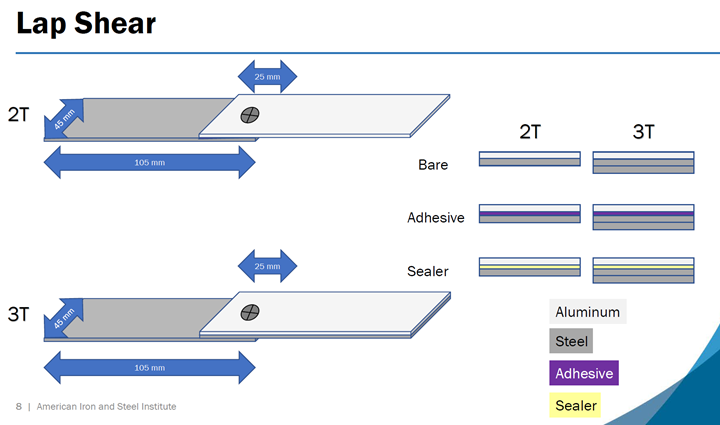Mixed Material Joining Study Performed
Let’s face it, steel and other materials—say aluminum—are going to be joined, so the Auto/Steel Partnership decided to determine what processes work best
#aluminum
As a mono-material automotive structure is a thing of the past, the Auto/Steel Partnership of the American Iron and Steel Institute, has undertaken a study of mixed material joining, determining the fatigue and corrosion evaluation of steel and aluminum coupons joined by three technologies:
- Resistance element welding
- Friction riveting
- Solid self-piercing riveting
According to Brian Macek, a senior technical specialist at FCA who is the project leader for the joining program, resistance spot welding was used as the baseline against which these other approaches were measured.

Joining test example. (Source: AISI)
They made the assessment predicated on a vehicle roof body-in-white (BIW) and a body-side BIW, with a bake-hardenable steel sheet replaced by an aluminum sheet.
The tests were performed on two thicknesses (steel/aluminum), with and without adhesives and sealer (each sandwiched between the metals) and three thicknesses (aluminum and two sheets of steel grades)—although for the materials joined by friction riveting, there were only two sheets of material, as that is what the process can handle.
Based on the tests, Macek says that all of the processes “performed adequately for two thickness joining” and resistance element welding and solid self-piercing riveting proved to be suitable for the three-thickness joining. He also said that they want to look at the performance of some emerging joining technologies, including thermally assisted clinching and thermally assisted self-piercing rivets.
You can see Macek’s presentation here.
RELATED CONTENT
-
The Bollinger B1: An Electric Sport Ute
The Bollinger Motors B1 has been revealed.
-
Light Vehicles and How They Got That Way
The approach that is clearly being taken by engineers to create vehicles is to use the right materials in the right places. The time of a single dominant material is gone and unlikely ever to return.
-
Aluminum Engine Block Casting Improved
.


.jpg;width=70;height=70;mode=crop)